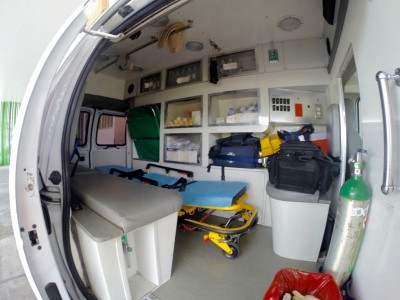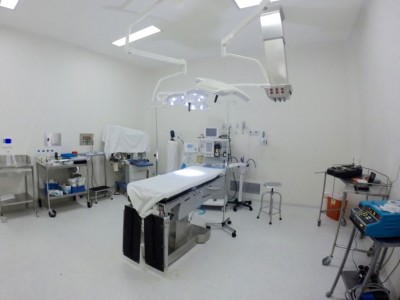My Paramedic Placement in Mexico
Published on Friday 5 February 2016Ebony Hewett
I stand crammed between people on a creaky bus, grasping onto a pole for dear life, my knuckles white. The driver accelerates with gusto and I look down to see bitumen racing by through a hole in the floor. More than once I have to apologise as I bump into people as the bus sways. A man tries to sell me chocolates in a language I barely comprehend, all eyes are on me; a white, blond Australian in a foreign land.
Welcome to Mexico!
This, my “life-threatening” daily commute (I say it with a hint of sarcasm but one person actually dies daily on the buses here), is to ‘Crusa Verde de Norte’ or the ‘Green Cross of the North’. This is a hospital and ambulance station in Zapopan, Guadalajara. Out of my element, but feeling more at home each day, I have travelled to Mexico to volunteer in the hospital and ambulance service for two weeks, through the Global Medical Projects organization.
The Green Cross Ambulance Service is one of the primary ambulance services here in Mexico. It boasts 5 ambulance stations in the Zapopan region. The Northern station, where I volunteer, is one of the busiest. The Paramedics have a one-year study program, followed by a four hundred hour placement commitment (usually taking approximately 6 months) to become fully qualified. The Ambulances are kitted out with a range of drugs and equipment, some which are similar or identical to SA Ambulance, others which are vastly different:
 Similarities – many similar drugs, similar airway kit and trauma kit, oxygen, able to intubate, radio communication, paramedics return to a home station, two paramedics work in partnership
Similarities – many similar drugs, similar airway kit and trauma kit, oxygen, able to intubate, radio communication, paramedics return to a home station, two paramedics work in partnership
Differences – some differing drugs such as frusemide and paracetamol solution, AED instead of ECG monitor, minimal paramedic specialization, able to suture (albeit uncommon), no pagers (solely rely on radios), less manual handling and safety precautions (gloves are infrequently worn and sharps are re-sheathed)
The biggest difference, however, is the type of work. My experience in Mexico in both the ambulance and in the hospital was that trauma equates to approximately 50% of the workload. When an ambulance is called it’s usually because the family literally can’t take the patient themselves due to the injury or complaint.
In the ambulance service I was always welcomed by the crew with a cultural kiss on the cheek and hug and often generously fed tacos or other delicious Mexican food. Although there was a communication barrier, I worked hard on my Spanish to understand as much as I could but will be forever grateful for universal sign language!
When I worked on the ambulance our shifts were particularly quiet for the region. However, we still attended multiple dislocations and broken bones, strokes, assaults and falls to name a few cases. To give you more of an idea of the work, one of the patients we picked up had fallen down two flights of stairs, resulting in a crushed vertebrae and two broken legs. The roads are so bad over here that three of us had to help hold her still in the back of the ambulance on the commute because she was bumping up and down so drastically. I’m not sure who was grimacing more – her, or me feeling so sorry for her! We also got called to a shooting, however on arrival we quickly established that a man was threatened with a pistol and punched in the face but fortunately not shot. Multiple paramedics informed me that shootings and stabbings are regular jobs, occurring weekly… it’s another world over here!
 I really enjoyed working in the hospital as I got to see multiple orthopaedic, paediatric and general surgeries; I got taught to suture; I was able to regularly cannulate and aid the doctors in a plethora of tasks. Again, we had many broken bones, we had deep lacerations to mend, brain lesions, large chemical and thermal burns, over doses, hypoglycaemic patients, asthmatics, anaphylactic patients, a newborn and even a lacerated eyeball as some examples. The work was very interesting and the trauma treatment very efficient given the ample practice. The most memorable job that I aided with was an elderly gentleman who fell over on concrete, breaking both wrists and receiving a nasty 15cm gash to his head. He had nicked an artery in his scalp causing a spurting flow of blood and an increase in sympathetic response. Having already lost approximately 500ml of blood and losing more by the minute (approximately 1L on completion), a doctor and I worked in unison to control the bleeding. We used countless gauzes and multiple clamps until we finally found the end of the artery and stopped its red stream. After a neat suture and IV saline the patient appeared a different person and was very grateful. It’s practical jobs like these that act as a kind reminder of the difference we can make, and what a priviledge it is to do so.
I really enjoyed working in the hospital as I got to see multiple orthopaedic, paediatric and general surgeries; I got taught to suture; I was able to regularly cannulate and aid the doctors in a plethora of tasks. Again, we had many broken bones, we had deep lacerations to mend, brain lesions, large chemical and thermal burns, over doses, hypoglycaemic patients, asthmatics, anaphylactic patients, a newborn and even a lacerated eyeball as some examples. The work was very interesting and the trauma treatment very efficient given the ample practice. The most memorable job that I aided with was an elderly gentleman who fell over on concrete, breaking both wrists and receiving a nasty 15cm gash to his head. He had nicked an artery in his scalp causing a spurting flow of blood and an increase in sympathetic response. Having already lost approximately 500ml of blood and losing more by the minute (approximately 1L on completion), a doctor and I worked in unison to control the bleeding. We used countless gauzes and multiple clamps until we finally found the end of the artery and stopped its red stream. After a neat suture and IV saline the patient appeared a different person and was very grateful. It’s practical jobs like these that act as a kind reminder of the difference we can make, and what a priviledge it is to do so.
I will miss the people I worked with and their friendly and generous nature, I will miss the Mexican food which far outweighs the Australian take on it and I will miss being able to assist Mexicans, young and old. If you are interested in doing this project or for more information please visit Paramedic and Emergency Medicine placements in Mexico or feel free to contact me.
Ebony Hewett
Paramedic Intern
South B
Awesome job Ebony. To follow in Ebony’s footsteps, find out more about our Paramedic and Emergency Medicine placements in Mexico
